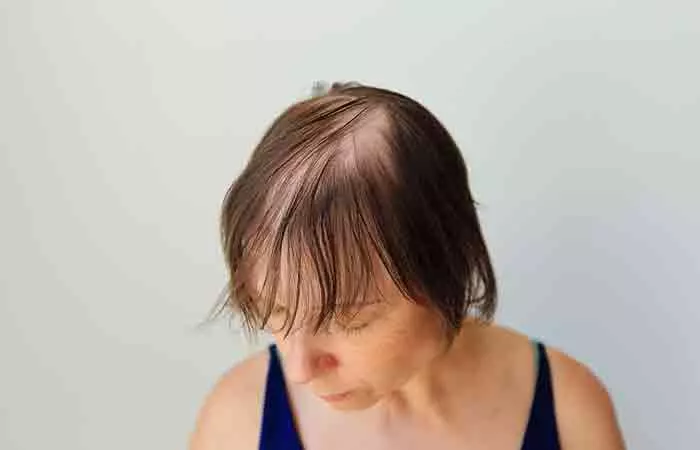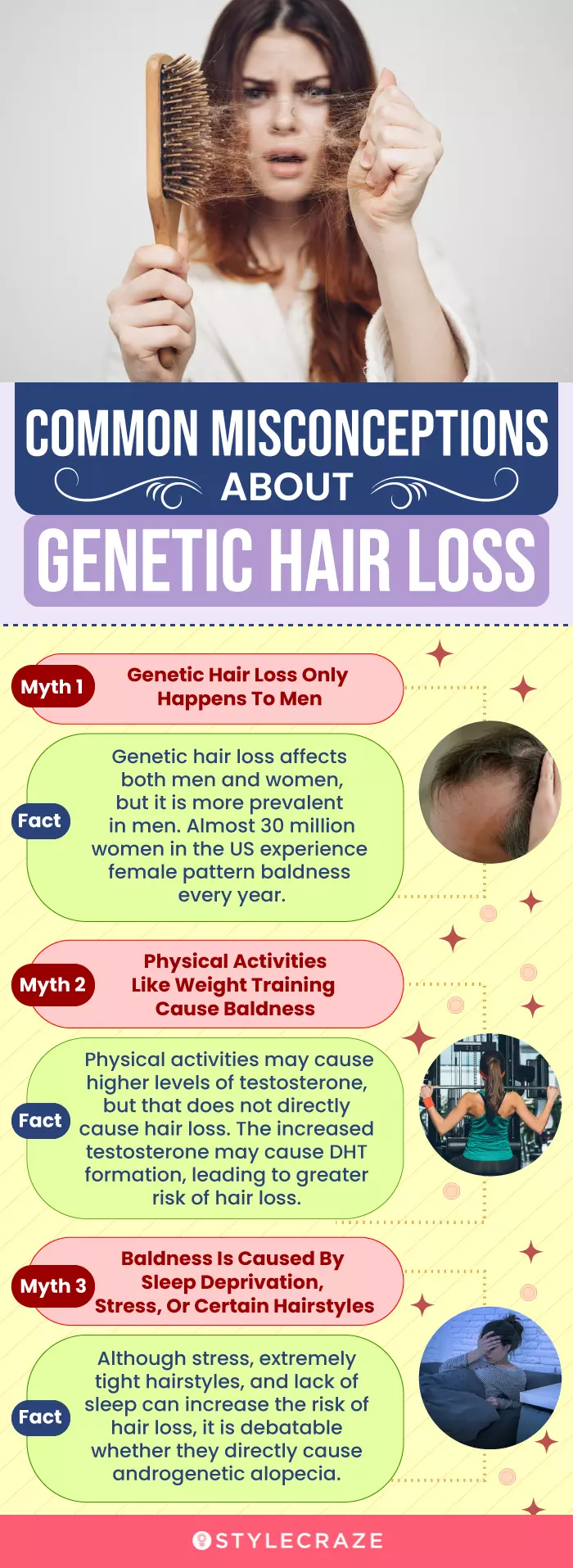An estimated 80 million people are affected by androgenic alopecia in the United States alone (1). In this genetically predetermined condition, the genes can determine the onset of balding. The growth phase of hair slows down and the hair follicle shrinks, causing hair follicle miniaturization. This can ultimately lead to hair shedding and produces shorter and finer hairs, leading to hair loss. Keep reading to understand the link between genetics and hair loss, its symptoms, and when you should see a doctor.
Genetic Hair Loss: What Science Says
Hair loss is distressing to deal with. You may have heard that if one of your parents or grandparents is bald, then there is a chance that you may go bald too. But, is it true? If it is true, then what is the link between heredity and hair loss? Let’s check out the scientific proof. You can observe hereditary hair loss in both men and women, which are known as male pattern baldness and female pattern baldness. Hair loss tendency on both sides of the family is responsible for genetic hair loss, and it accounts for nearly 80% of this condition (2). A cohort study conducted between January 2016 and December 2019, involving 18,368 participants, aimed to determine the annual prevalence and incidence of Alopecia Areata (AA) and Alopecia Totalis/Universalis (AT/AU) in the United States. The study revealed that the prevalence increased from 0.199% to 0.222% over the period. It was also found that females were more likely than males to experience the prevalence and incidence of Alopecia areata.
Male Pattern Baldness
Male pattern baldness (MPB) often starts at the age of 20 or 30 as an M-shaped recession of the hair at the front of the scalp. Male pattern baldness affects 80% of men by the age of 80 (3). How quickly or slowly baldness develops is determined by the genes that you inherit from your parents. A study conducted at the Wright State University School of Medicine (USA) found that the probability of hair loss in males is dependent on family history and age (4). Though the genetic component responsible for male pattern baldness is not well understood, it is believed that it involves more than one gene (5). Humans have 23 pairs of chromosomes in which all the genetic information is stored. One of these sets of chromosomes are comprised of X and Y chromosomes, which determine your gender. Babies inherit characteristics from their parents through these chromosomes. Baldness is closely associated with the androgen receptor (AR) gene found on the X chromosome (4). Men inherit this X chromosome from their mother (6). Men with AR genes have been found to have a tendency to develop male pattern baldness or androgenetic alopecia more than people without it (7). Are only AR genes responsible for genetic hair loss out of the thousands of genes in the human body? No, research has also found that along with the AR gene, 63 more genes may play a key role in male pattern baldness (9). However, more research is required to understand male pattern baldness and the genes responsible for it.
Female Pattern Baldness
In females, hair loss is gradual, and it can occur after the menopause stage, but some women may experience it sooner. Approximately 40% of women experience hair loss by the age of 50 and 55% of women by the age of 80 (10). When compared with male pattern baldness, female pattern hair loss may be less obvious as it presents in a different way to men. The gene responsible for this still remains unknown (11). It is believed that, like MPB, it also involves multiple genes. Generally, at least a quarter of all women experience some degree of hair thinning by the age of 50. Also, you can observe finer hair with less color at this stage. Along with hair loss, you can also inherit sensitivity to one of the male sex hormones, DHT (dihydrotestosterone). DHT causes your hair follicles to shrink, which then leads to baldness (12). At puberty, testosterone starts circulating in the body if you are genetically predisposed to testosterone sensitivity. Unfortunately, this pattern is set. Testosterone binds to the AR receptor in the follicle with an enzyme called 5-alpha reductase (5AR). This converts the testosterone into the more potent dihydrotestosterone. This results in the follicles becoming miniaturized, creating shorter and finer hairs with each successive shortened anagen phase. You may notice progressive thinning hair or balding if you have hereditary hair loss. But, is it the same in both males and females? Find out more in the following section.
Symptoms Of Genetic Hair Loss
In males, you can observe progressive thinning of hair, which starts with a receding hairline. This condition then leads to a bald spot at the crown area of your head. In the advanced stages of hair thinning, you may notice a rim of hair along the back of the head. In females, you rarely observe bald patches. But, you may notice thinning of hair at the top of the head. For women, the temples and forehead areas are not usually affected. Most women report a widening of their parting, which shows more scalp. You may observe thinning of hair as you age. But, if you notice it early in your life due to hereditary factors, can you reverse it? Find out in the next section.
Can You Reverse Genetic Hair Loss?
You cannot cure genetic hair loss. But, there are some options to slow down hair loss. Certain medications are prescribed by doctors to slow hair thinning, and you have to be extremely disciplined when taking them. These medications include:
When Should You See A Doctor?
Hereditary or genetic hair loss is natural. But, there could also be an underlying health condition causing your hair loss. If you observe sudden and patchy hair loss, scarring, flaking, redness, or hair falling out more than normal before your 30s, then you should consult a doctor. Nijiati Abulizi, a blogger, recounts experiencing sudden hair loss in his late twenties, leading to a decline in confidence and self-esteem. A doctor diagnosed him with androgenic alopecia, offering two options: embrace the change or use Finasteride [medication]. He recounts, “I decided to do my own research and reverse my hair loss. I had to convince my doctor to do a complete blood test to find out I had an ongoing H. Pylori infection in my stomach. Then I was treated for it. I also worked hard to resolve the inflammation in my body caused by this bug. Lo and behold, after a few months my hair started to grow back (i).” There are a few popular myths about baldness and hereditary hair loss. Learn more about them in the next section.
Key Takeaways
Key Takeaways
Myths Associated With Genetic Hair Loss
Myth 1: Genetic Hair Loss Only Happens To Men Hair loss in women is pretty common too. In fact, it is estimated that nearly 30 million women in the United States alone experience female pattern baldness (1). They also experience more hair thinning, usually at the parting. The hair loss in women just presents differently from men. Myth 2: Physical Activities Like Weight Training Cause Baldness Although many studies do prove that physical activities enhance testosterone levels, there is no direct evidence that confirms a link between exercise and hair loss. It is believed that men with high testosterone levels have higher chances of male pattern baldness. However, it is important that this hair loss only occurs in men and women who are predisposed to testosterone sensitivity. Myth 3: Baldness Is Caused By Sleep Deprivation, Stress, or Styling Options Stress, super-tight hairstyles, and sleep deprivation can cause hair loss, but it is totally different from genetic hair loss. However, the link between these factors and hair loss are not well established. Myth 4: Baldness skips a generation While it may seem like baldness skips a generation, it is necessary to understand that hair loss patterns are complex and can be influenced by multiple genes. Androgenetic alopecia is typically hereditary and can be inherited from both sides of the family. In some cases, it may appear to skip a generation due to the presence of different genetic factors at play. Some individuals may carry the genetic predisposition for hair loss without displaying noticeable signs until a later age. Additionally, a range of factors, including hormonal changes, can influence genetic expression. While there is a genetic component to baldness, it does not strictly adhere to a predictable generational pattern. Hence, making predictions about hair loss patterns is challenging.
Conclusion
Is hair loss completely genetic? No. Stress, nutrition, lifestyle, underlying medical conditions, and environmental factors can also trigger hair loss. At what age does genetic hair loss start? Genetic hair loss generally begins around the late 20s or early 30s. Is hair loss genetic from mother or father? Yes. Hair loss can be genetic and passed down from either parent (17). Explore the role of genetics in hair loss. Watch this video to understand how genetics can impact your hair growth and lead to baldness. Check it out!











